The one surface that is used in every space in your home is your flooring. While it may not be top of your list when planning for a kitchen design or bathroom remodel, your flooring is an essential surface. It must withstand constant foot traffic, moisture, spills, dirt, pets, and dropping heavy or sharp items.
Your flooring also covers a large surface area that is highly visible and therefore influences your room’s style. Even if it is not the first thing you select when creating your design, flooring often plays a key role in linking together different elements of your design with its material, texture, color, or pattern.
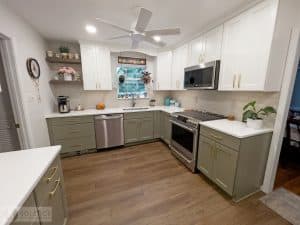
Floor materials also help to delineate different rooms or areas in an open-plan layout, by using different flooring materials to transition from one area to the next. Alternatively, you can select a single flooring material to use, for example throughout your first floor, which helps to link these areas and encourage a flow of traffic throughout the space.
Two of the top choices for flooring for home remodeling are luxury vinyl tile/planks (LVT/P) and hardwood flooring. Deciding which one is best for your home depends on several key factors including appearance, cost, durability and maintenance, sustainability, and more. LVP has come a long way in terms of look and feel and how closely it can mimic hardwood flooring, so it can be a tough choice when trying to decide on a material for your home remodel. Start with our guide to these two popular flooring options.
What is Luxury Vinyl?
Before examining the pros and cons of each material, it helps to first explain exactly what we mean when we talk about these flooring surfaces.
First, let’s talk about luxury vinyl. This material comes in either tiles or planks and closely mimics their natural counterparts. LVT/P is made up of PVC and other materials, and based on the materials used it can be a harder or softer surface. The layers are compressed and heat-treated, which is what makes LVT/P such a durable surface. To give luxury vinyl its design aesthetic it is then covered with a vinyl photographic image of your chosen style and a protective layer of urethane.
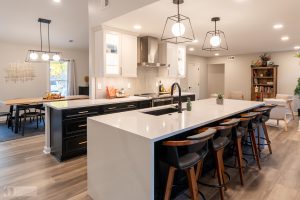
What is Hardwood?
Hardwood is a natural surface that comes in both solid hardwood and engineered hardwood options. The solid variety can be produced from a variety of wood species and then cut into planks of varying lengths and widths. Engineered hardwood is another option that places a layer of natural wood on top of layers of wood by-products. It offers an alternative to solid hardwood but gives the appeal of wood since the top layer is natural.
Weighing Up the Differences
When choosing which material is right for you, you need to consider your lifestyle, home design, and personal preferences. Are you willing to commit to the long-term maintenance required for hardwood to get the appearance of a natural product? Do you have young kids and pets to contend with and therefore need a surface that is easier to clean and maintain?
Several factors will determine which material is the best choice for you. To help you in your quest for the perfect flooring material, let’s explore the pros and cons of each based on different factors.
Appearance
Both surfaces are stylish choices that can fit into any home design style, but there are subtle differences that may impact your choice.
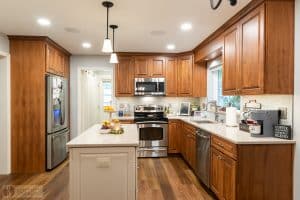
Hardwood:
Pros – Hardwood flooring is well-known to be a timeless material that has a unique quality due to its natural beauty. Each piece of wood is one-of-a-kind with its knots and grains. It feels warm underfoot and, depending on the wood type, plank style, and finish you choose it can fit into any home design style. You can choose any plank width to get the look you want and can even mix wood finishes to get a trendy multi-tonal appearance. Wood can be topped off in either a polished or distressed finish, and you can refinish it over time to change its appearance as your style preferences change.
Cons – If you prefer a more uniform look to your flooring then wood may not suit you, as the appearance of each plank may differ depending on the wood you choose. You also need to weigh up the benefits of wood’s appearance with other factors, such as durability.
Luxury Vinyl:
Pros – With the latest technological advancements, LVP can so closely mimic the appearance of hardwood that you would hardly notice the difference between the two. Since you are using a photographic image of the natural substance, it is possible to recreate any type of wood, grain, color, or finish to give it exactly the appearance you want. It will never match up exactly to natural wood but can be close enough that you could even lay it next to hardwood in two adjoining rooms. If you love a symmetrical look then LVP could be the perfect answer, since the planks are covered in an image that repeats.
Cons – Although LVP comes close, it can never exactly match up to natural hardwood. Natural materials bring a unique flair to any design due to their individuality, slight imperfections, and texture. You also cannot refinish vinyl, so you must commit to the look of the LVP you select for the lifetime of that flooring.
Durability
Both surfaces are long-lasting though LVP has some extra benefits when it comes to durability.
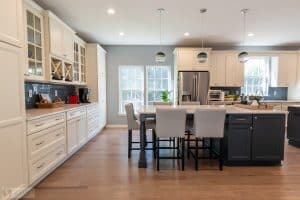
Hardwood:
Pros – Hardwood has been around for a long time and is a naturally durable surface. You can give your hardwood flooring extra protection with a coating applied in the factory when it is produced. Since it can be refinished over and over, the life of hardwood can be extended for decades.
Cons – Hardwood is not suited to high moisture areas so it is not a good choice for bathrooms and should be used with caution in busy kitchen designs. Moisture can cause hardwood to swell and warp, so if you choose to use it in a kitchen consider using mats or rugs near the sink and clean up any spills quickly. Hardwood can also be scratched, particularly in a kitchen subjected to foot traffic, pets, and dropping heavy or sharp items.
Luxury Vinyl:
Pros – Luxury Vinyl is an exceptionally durable surface that is moisture and climate-resistant. It stands up to heavy traffic and daily use and does not damage easily, making it one of the most durable, hard-wearing, and low-maintenance materials available for flooring.
Cons – While it is a durable, long-lasting surface LVP is not indestructible. Since it cannot be refinished like hardwood, it will need to be replaced eventually.
Maintenance
Similarly, when it comes to maintenance, LVP wins out as an easy-to-clean and maintain surface.
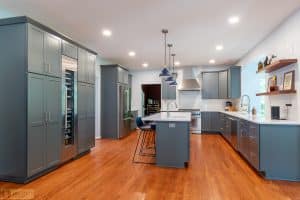
Hardwood:
Pros – Although hardwood is more prone to getting scratched by foot traffic, pets, moving furniture around, or dropping things on it, this could be seen as part of its natural appeal. These slight imperfections give it character over time. Additionally, hardwood can be refinished many times meaning you can extend its life indefinitely.
Cons – Hardwood does require careful attention and maintenance to keep up its appearance over time. You must clean up spills or splatters immediately as they can warp or damage your flooring if left to soak into the surface. Some products can also leave oily stains so be careful what you use around hardwood flooring and pay attention to any spilled products. Unless you love the look of worn hardwood flooring then you will need to refinish it in years to come.
Luxury Vinyl:
Pros – LVP is incredibly easy to clean and maintain. You can use virtually any type of floor cleaner, it can be swept or vacuumed, and dirt and spills come up easily. The protective top layer used in producing LVP is clear polyurethane, which protects all of the sublayers. There are no ongoing requirements to reseal it or do any additional work to maintain it.
Cons – If it does get nicked or scratched, it cannot be refinished like hardwood.
Cost
Both hardwood and LVP are luxury products, so they both come with a price tag that reflects their quality.
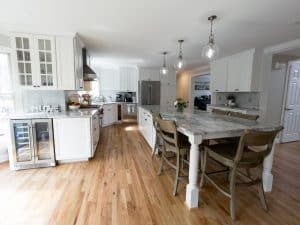
Hardwood:
Pros – Although quality hardwood flooring comes with a luxury price tag, you can’t beat its timeless appeal so you know you are choosing a surface that will never go out of style. Best of all, if you get tired of its color or finish, you can refinish it to update the style without having to replace the surface.
Cons – Hardwood production requires several stages including growing, harvesting, milling, and finishing. Since this takes time and requires multiple locations it tends to increase the cost of the final product. It also requires professional, skilled installation and must be carefully stored and acclimatized before installation, which also affects the overall cost of this product.
Luxury Vinyl:
Pros – LVP is a luxury surface that brings a stylish focal point to your home. The latest advancements in technology to produce LVP mean that it also carries a higher price tag. The higher the quality, the less Volatile Organic Compounds (VOCs) will be in your flooring surface, which is beneficial to your health. It is slightly less expensive than hardwood, and it is easier to install which also reduces the overall cost of choosing this surface.
Cons – If you decide to cut corners by going for a lower-priced LVP, you run the risk of choosing a surface that is not as durable and contains higher levels of VOCs.
When planning a kitchen remodel or bathroom design, there are many choices to make from cabinetry to tile, color schemes to appliances, and much more. Flooring is a key element of every space in your home, and it is a surface that must look stylish while withstanding a constant onslaught of people, pets, spills, dirt, and more. Examine your needs first by looking at your home’s style, your family and lifestyle, personal preferences, and budget. Talk to our team at Solstice Kitchen and Bath about your kitchen and bathroom remodeling needs, and we will help you find the perfect products and create the ideal design for your home.
